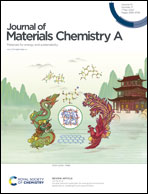High performance poly(methyl methacrylate) via hindered urea bond crosslinking†
Abstract
Poly(methyl methacrylate) (PMMA) is an important engineering plastic that has numerous applications. However, owing to its poor mechanical strength, highly brittle nature, and inferior environmental resistance, its practical usage is limited. Diverse research efforts towards making PMMA more robust, tough, and environmentally resistant, while retaining its optical characteristics and recyclability, are currently underway worldwide. However, because of the mutually exclusive properties of stiffness/strength and toughness, as well as the intrinsic gap between thermoplastics and thermosets, it is difficult to simultaneously optimize them. Herein, we report a straightforward, catalyst-free, fast and efficient preparation of colorless and transparent high performance PMMA via hindered urea bond (HUB) crosslinking strategies. Implanting HUB crosslinks into PMMA networks substantially improved Young's modulus, tensile strength, strain at break, and toughness in comparison with those of thermoplastic PMMA. More importantly, HUB crosslinked PMMA achieved a brittle-to-ductile transition, suppressing catastrophic fractures. Additionally, HUB crosslinked PMMA exhibited excellent solvent and high temperature creep resistance and retained mechanical/appearance stability under harsh conditions, and could also be recycled and repaired via the reversible exchange reaction of HUB crosslinks. The results of this work provide an unfilled strategy for the construction of high performance sustainable PMMA with potential to be extended to other commercial thermoplastics.



 Please wait while we load your content...
Please wait while we load your content...